
What is the Difference Between Pneumatic and Cushion Forklift Tires?
You’ll need to make a wide range of decisions as you choose the right forklift model, the right features and the right equipment components for your workplace. And one of these decisions will involve your choice of tires. The two most common tire options include combustion pneumatic and IC cushion tires, and the choice you make will depend on your forklift application and your industry. Most forklifts are designed to handle either one type of tire or the other, so if you have a specific model in mind, you may be committed to a specific tire choice. Here are a few key differences between the two.
Pneumatic Tires
These tires are similar to car and truck tires, since they’re made of rubber and some are inflated with air. These tires are generally chosen for their versatility, since they’re designed to maintain a firm grip on uneven surfaces. They’re suited to indoor-outdoor environments, wet conditions, uneven ground and unpredictable ground cover, slopes and obstacles like those found on construction sites. Air pneumatics are inflated and may sustain punctures, but solid pneumatics are puncture proof and are made of extra-tough, non-inflated rubber compounds.
Cushion Tires
Cushion tires are built around a much simpler design and are comparatively maintenance free. They’re composed of a single piece of solid rubber wrapped around a metal band, so they don’t puncture, bend or deflate. They’re easy to both manufacture and maintain, but unlike inflated tires, they can’t handle tough or unpredictable conditions. They’re designed for smooth manageable surfaces, like the floor of an indoor warehouse. These tires offer one key advantage over their counterparts; since they don’t grip surfaces very tightly, they offer a smaller turning radius and function well in narrow spaces.
Before you decide, consider the terrain and conditions in which your lift truck will be used, and of course, always prioritize the safety of your operators. Make sure your teams are prepared for both the handling and maintenance challenges of the forklift model you choose.

